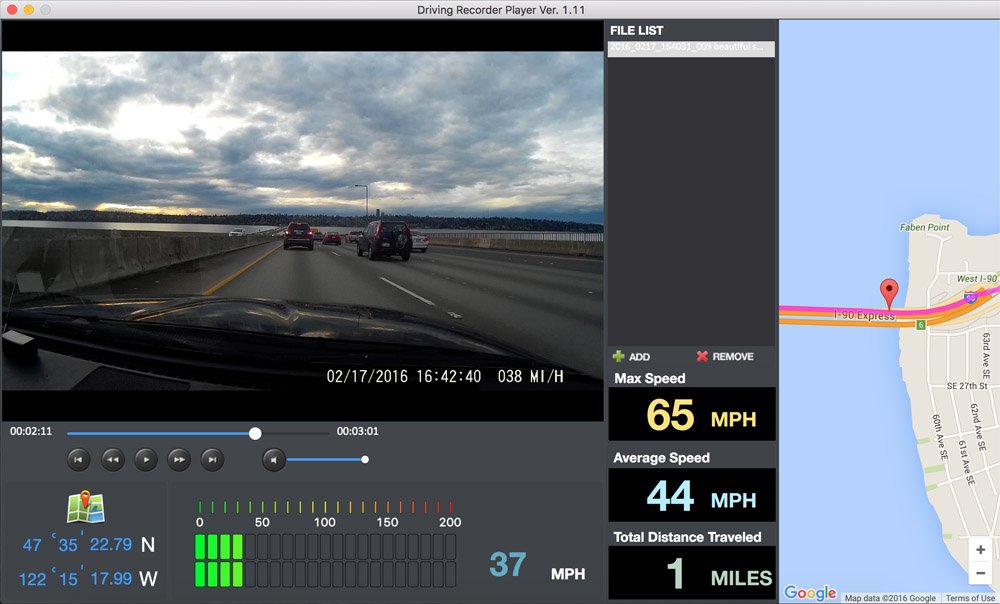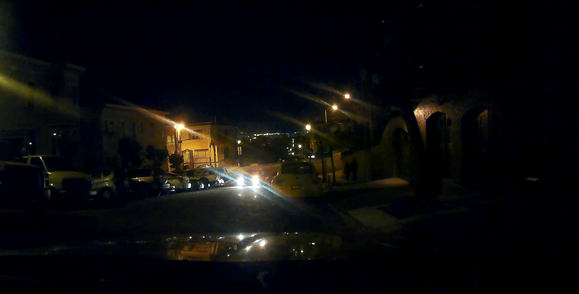Kdlinks X1 Review

KdlinksX1 Review: This Dash Cam’s GPS Lacks One Key Feature
Amazon’s X1 Dash Cam is a very popular one. It costs just $170 on the street, but includes the following features: A nice 2.7″ display, GPS (a separate unit/mount that plugs into camera), 8GB of SD Card (free), and 1080/160-degree video. This dash camera has the best field-of-view of any other reviewed, and captures things in the margins.
Daytime video from the KDLinks Dashcam X1 is a bit too exposed, but it’s otherwise very good.
Although the video quality is good on the X1, it’s slightly under-exposed in the default settings. It also suffers from fish-eye due to the extremely wide field of view, but if that becomes an issue you can always employ a de-fishing filter in your video software. Mercalli has a great standalone flattener for fish-eye that is called DeFishr.
The X1 is small, thin, and light with a relatively inconspicuous/easy-to-adjust locking suction mount. KDLinks has two types of mounts. One with GPS modules and one without. KDLInks docs, like many of the others assume a lot of knowledge and unfortunately, you’re likely to need them. The interface on screen is not intuitive and navigation is difficult with the same buttons found on both sides. It is possible to use after some fiddling, I’m sure. Fortunately, all dash cams are pretty much set-it-and-forget-it, so you don’t have to fiddle very often.
The KDLinks X1 dashcam has the widest field of view of any of the dashcams we tested, at 160 degrees (in 1080p).
Problem with the X1: You must manually set date and time. Use the GPS information for this. Yes, it does have the GPS mounted. If you do need to save energy, then you could use the alternative mount.
One strength of the X1 X1 is its use of a micro USB port for both power and video offloading to PCs. This eliminates the requirement for a microSD cards reader. When you connect the X1 to a PC, it can be turned into a web cam. Nice.
Review: Kdlinks X1 Dashcam
This is my review for KDLinks’ X1 dashcam.
Overall, the X1 is well designed. Excellent picture quality. I was unable to see the license plate numbers at night due to blurry reflections, however. The customer support staff is responsive. Installation is fairly simple if you have enough space behind your rear-view camera to use the suctioncup. The suction cup will not work if the surface is rough.
These qualities are all well-documented on the web, so I will not dwell too much. Instead, let me focus on one thing that I think most people have overlooked: how the camera actually captures and saves footage in emergency situations.
You can do it automatically by using an acceleration sensor which triggers collisions or manually by pressing a button called “lock”. The two options are said to be able to make sure that recordings of the past n minutes (configurable up to 1, 2, or 3 minutes) do not get overwritten.
I had no spare car and couldn’t test acceleration sensor.
KDLinks has deliberately kept the manual offline for unclear reasons. The manual claims that pressing the lock button will save the video’s last n minute and prevent it from being overwritten. This is my view and the main function of any dashcam. Because it’s most needed when users are most likely to be agitated or unable to remember complicated instructions, saving footage should be simple and reliable.
Unfortunately, there is more to the locking button than you might think. And even worse, none of what I’m describing here is actually mentioned in the manual. In other words, if you rely on your X1 working without having tested it several times, you might be in for an unpleasant surprise when you actuallly need the footage. Three issues are involved:

Lcd Screen
One of the things I was most curious about was the LCD screen on the back. Although I don’t think it would have been necessary on my first camera, it intrigued me.
It is very handy. When you first position your camera, it can help to verify your framing. With my other cameras it’s really a matter of trial and error. To record some video, you can put your memory card into your computer. Next, adjust the camera by placing the card in again. Having an LCD helps avoid this, but once you get it set up, do you need it afterwards?
The camera has the ability to rotate or point at various angles, which can come in handy when you need to capture something along the side of the road. Also the LCD can allow you to reposition the camera afterwards. This can be used to adjust your camera settings on-camera. You can even go back later and make sure that you capture an event.
A small battery is included so that you can either walk around the car and take photos, or use it to record. So while you don’t need the LCD really, it does open up some helpful benefits that I hadn’t thought about before.
While there are many other aspects I could highlight (and they’re covered in the review video at top), these are my highlights.
KDLINKSX1 software is available both for Windows and Mac. The interface is pretty clean and simple. There isn’t much to do in the app, as you control the camera from within the program.
This app allows you to playback footage of your clips, show your average speed, max speed, and the total length of roads you traveled in that particular clip. (If you record in 3 minute chunks, it will show you just that 3 minute chunk.) You can only upload one file at the time, which I found annoying when trying to upload multiple files. I love the fact that GPS information is embedded directly into movie files. It means you only need one file per clip. This is not the case with two files (one for GPS and the video). You can manage the video files more easily and the software won’t get confused if you need to rename them to be more useful. When you name the video file but not your GPS file in other programs, it doesn’t know how to link them. So you won’t have access to your GPS data. Because it is only one file, you can use it on your computer. I like that.

Cons
You need to enter date and hour manually
A large viewing angle can cause distortion (very minimal) near the video‘s edges.
Despite the minor quibbles, the KDLINKS X1 Full-HD dashboard camera will make a fantastic addition to your vehicle’s accessories. You can get things you can’t with traditional cameras due to its wider angle of viewing. It offers clearer, sharper videos.

Kdlinks X1 vs Dx2 review
Bert * April 24, 2020* No Comments Dashcams offer great protection in case of an unfortunate accident. Problem is that there are so many of them on the marketplace, it is difficult to find one that offers you the right level of protection. KDLINKS seems to be the company who has hit the mark with this product. Let’s take a look at two of their most popular dashboard cammodels, the X1 & DX2.
KDLINKSX1 has been on the market since late 2014. Since then, it’s been a hit. There are good reasons for this. Let’s begin with the look. It features a 2.5-inch LCD display that has a 160° Full HD (1920*1080 resolution). You also get a removable GPS module as well as an 8GB SD memory card.
This equipment is professional in looks. The exterior is sleek and small with a matte black color that matches perfectly any dash. The camera comes with an easily adjustable locking suction mount. This ensures that the camera remains in its place, but can also be removed when it is not being used.
Also, the operation of the X1 dashboard cam is simple. It automatically records and loops, so it is ready for use right out the box. Also, it comes with night-vision and six-glass Nikon lenses.
The main downside with this model is there’s no timestamp function which can be bad if needing to use in a legal situation. But, it is still possible to set date and time manually.
Now you know what the little sister camera offers, and it’s now time to find out what your big brother has.
The first upgrade to note is the DX2 is a dual-camera dash cam system. With one 1080p resolution camera with a 165-degree field of view facing the front, and one 720p resolution camera with a 125-degree field of view facing the rear the total field of view on this thing is staggering 290 degrees.

Review Part 1: Kdlinks Dash Cam Dx2
Kurz: The kdLinks Dash Cam DX2.
KDLINKS Full-HD 1080P front + 720P rear 290deg Superwide Angle Car Dash Cam, G-Sensor and WDR Superior Night Mode. 1 year Dashcam Warranty.
That’s quite a list. Plus, it has a backwindshield-mounted video camera. The “name” above did not explicitly state this fact.
Unpaid, unspecified, and objective reviews are split into two parts. There is a philosophical part and there is also a data driven, descriptive side. The philosophical part of this review is the first.
Lets begin, then, with Part 1, where we compare the kdLinks X1 and DX2 cameras. Let me just say up front that this part of the review is the part you don’t see on reviewer’s web sites, many of which are clones, and which get click-through revenues from a link to where you can buy this camera.
I was surprised to see that the kdLinks DX2 cameras, published July 26, 2016, have only one page. That page is located on the product page. Aside from that page, there are no other links on the site to software updates, users manual or other information for the DX2. You will find the majority of content about the X1, a 2014 camera. It’s not surprising. There are more X1 users. By far.
.Kdlinks X1 Review
